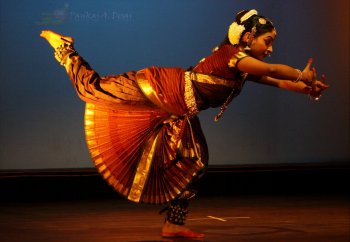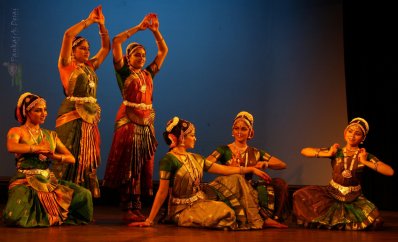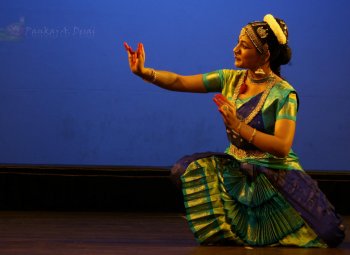
|   |

|   |
Sai Nrithyotsava 37 - Chittaranjan Mothikhane e-mail: chittaranjanmothikhane@gmail.com Photos: Pankaj A Desai June 7, 2012 A platform for dance gurus to present their upcoming disciples, young choreographers to share their creativity, established dancers sharing the hallowed space adding prestige to the festivity, from entertaining Mama-Mamis and yuppies of Bangalore being inducted into classic arts is what Sai Arts International has achieved. With Sai Nrityotsava 37, the “Masika-Nrithyotsava” steps into its fourth year of celebrating Indian classical dance. The log of events for past 3 years figures 180 teams, more than 600 dancers hailing from all over the country and abroad. On the 1st of June, the Seva Sadan Auditorium in Bangalore witnessed three solos and one dance feature that enthralled the prekshakas, many who were addicts to the festival and some new rasikas. In the opening segment, Bharatanatyam dancer Gowri Sagar under the watchful eyes of her guru Sathyanarayana Raju invoked Ganesha through a stuti in raga Sriranjini set to adi tala. Before she wound up her presentation with her Tillana in Valachi - adi composed by Dwaraki Krishnaswamy that paid obeisance to Goddess Shakthi, Gowri demonstrated her ability to swing between tandava and the lasya of Ardhanareeshwara within the quick shift of right foot and the left and the blink of the beholders’ eyes. The Muthuswami Dikshitar composition on this duality of gender set to Kumudhakriya raga and adi tala, won applauses at the right moments of freezes. Gowri’s rendition of Adi Shankaracharya’s Panchakshari Stuti was pleasingly different especially when it was tuned to a raga that was influenced by Bhatiyaar.  Gowri Sagar  Disciples of Suparna Venkatesh Dr. Suparna Venkatesh, through her disciples Shweta Venkatesh, Shamika, Kavyashree, Pushya, Sindhu and Anjana, exhibited in a seamless 45 minutes Bharatanatyam based dance-scope, the DASHA AVATARAM of Lord Vishnu. Madhvacharya considered Krishna as the divine entity that’s a Poornakrithi. Linking Him to Vishnu, his composition eulogizes the several avatars that the Lord had to take to redeem, to cleanse and to restore order on this earth spanning between Yugas. What sets this composition different is in its description of the Buddha avatara as not that of the Bouddha Dharma but Vishnu who did the Bhodane to the Suras after accomplishing his supportive feat of seducing the chaste wives of Tarakasura while Shiva was engaged in his annihilation of the asura. Choreographically, it was interesting to see as a prologue, the episode of Jaya and Vijaya being cursed by the muni and the options given by Lord Vishnu to come back to Vaikunta soon after serving the curse, presented in crisp, quick animated freezes. The all female ensemble through brisk movements created beautiful imagery of the ten episodes punctuated by energetic nritta that was interspersed as transition from one avatar to the other. The next presentation of the evening gave a break to the geometric precision of Bharatanatyam by bringing in its third segment the sensual and languorous Odissi. Shweta Krishna, who comes from the portals of Nrityagram and furthered her dance art under Sharmila Mukerjee, sought the pardon of Mother earth before she would stamp on her during her performance, invoked the blessings of Rama, the patron deity of Goswamy Tulasidas, and offered her pranams to the Gods, to the Guru and then to the audience through her Trikhandipranam in her opening Mangalacharan. The stuti “Keykikantha” of Tulasidas sees the likeness of Rama’s color to that of the radiant glow of a peacock’s neck. Pallavi in Megha raag that followed was performed in gay abandonment celebrating the joy of Spring. The concluding Ashtapadi of Jayadeva that meandered between the description of the beautiful lord and several of his deeds was steeped in great devotion to Krishna. Shweta Krishna’s dance to Khamaj raag - Jaati taal, justified the joy that Jayadeva derived in singing this auspicious song that pleases all.  Shweta Krishna  Smriti M Harits Smriti M Harits, disciple of Vasundhara Sampath, gave a befitting concluding act to an evening in celebration of dance. She rendered Subbudu’s composition, in raga Valachi set to tala adi. Smriti’s smart choice of doing one number tailored to the allotted time, kept her audience seat bound and took them on a wave of emotions that was experienced by Devayani. The heroine’s conversation with her sakhi hinted at the nayika’s vipralabdha state of emotion. The swing between the sadness of separation from her Lord Muruga to the jealousy that lingered in her heart about the possible proximity of Valli was well brought out in her abhinaya as much as she succeeded in the interspersed nritta in this varnam. While all other presentations were performed to recorded music, Smriti had Bharathi Venugopal sing the composition “Anname aruginil vaa, antharangam ondru sollven keladi,” with nattuvangam by Pallavi Manjunath. Purushottam supported with rhythms on mridangam and Nataraja Murthy gave the melody on violin. Thanks to the efforts of Sai Venkatesh, Dr. Suparna Venkatesh and all those who are part of the show, with a special mention of Mysore B Nagaraj, who is eloquent and articulate in his anchoring. He narrates in a way that is suited to today’s sensibilities. The uneasy feeling of having to wait a month to see the next Nrithyotsava was heavy in the air and that speaks about the success of the monthly event, now entering its fourth year. |